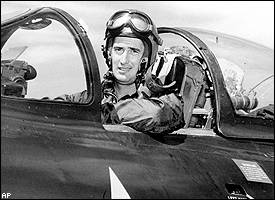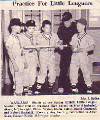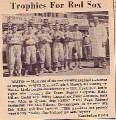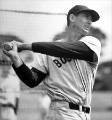| |
Local Historians: Kyle Olmstead, Bill Kaplan
Baseball was a way of life in the 1950s throughout the country. The time period was marked by heroes such as Jackie Robinson, the first African American baseball player, who played a majority of his major league career during the fifties. It was also marked by ludicrous moments such as when 3' 7" Eddie Gaedel was put in to bat for the St. Louis Browns; the first African American baseball player, who played a majority of his major league career during the fifties. It was also marked by ludicrous moments such as when 3' 7" Eddie Gaedel was put in to bat for the St. Louis Browns;
 his strike zone was so small that the pitcher walked him on four pitches, allowing Gaedel to secure the highest on-base percentage of all time. Meanwhile, other players such as Willie Mays and Ted Williams
shattered records during this time, and Ted Williams was not only regarded as a great baseball player but also as a patriot to his country when he left the Red Sox in 1950 to fight in the Korean War. his strike zone was so small that the pitcher walked him on four pitches, allowing Gaedel to secure the highest on-base percentage of all time. Meanwhile, other players such as Willie Mays and Ted Williams
shattered records during this time, and Ted Williams was not only regarded as a great baseball player but also as a patriot to his country when he left the Red Sox in 1950 to fight in the Korean War.
Baseball was not a sport that was just for the players, it was sport in which loyalty extended from fans to teams and from teams to fans. Thousands of spectators flocked to ballparks around the country each day to cheer on their favorite teams, and in return each team strove to put on a show for the fans. An example of the efforts of the players was exemplified in 1957 when the Brooklyn Dodgers, amidst ailments, old age, and rumors that they were soon to be moved to the west coast, played some of their best ball ever and put on quite a show during the 1957 season, finishing just eleven games out of first place.  The 1950s were also a reminder that the sport of baseball was becoming more and more of a business. Daniel Okrent spoke of the Dodgers move to the west coast and said, "It ripped at the loyalties of people who felt that the teams were as loyal to them as they were to the teams, that it was a two-way street. And it was probably the first time in... thirty years that fans were reminded that this was a business as much as it was a game." The 1950s were also a reminder that the sport of baseball was becoming more and more of a business. Daniel Okrent spoke of the Dodgers move to the west coast and said, "It ripped at the loyalties of people who felt that the teams were as loyal to them as they were to the teams, that it was a two-way street. And it was probably the first time in... thirty years that fans were reminded that this was a business as much as it was a game."
In Wayland, the Little Leaguers strove to mimic their Major League counterparts. All of the Little League teams shared names with major league teams such as the Giants, the Red Sox, and the Dodgers. The big game for the players was "under the lights" at Cochituate Field, just like the games were at Major League parks like Fenway and the Polo Grounds. The A-League (All-star) team seemed to have the biggest connection to the Major Leagues, specifically the Red Sox. For a stretch, the Wayco (Wayland-Cochituate) A-league team's uniforms looked the same as the Sox and were named the Red Sox. As the Boston Red Sox played baseball games away from Fenway and in other states, the Wayco Sox played games in other towns. Unlike the Boston Red Sox at the time, however, the local Sox finished the season with a winning .600 record! The sport in town had hints of what was to come in the Major Leagues currently today, with there being chronic absenteeism due to camps and other activities. The big game for the players was "under the lights" at Cochituate Field, just like the games were at Major League parks like Fenway and the Polo Grounds. The A-League (All-star) team seemed to have the biggest connection to the Major Leagues, specifically the Red Sox. For a stretch, the Wayco (Wayland-Cochituate) A-league team's uniforms looked the same as the Sox and were named the Red Sox. As the Boston Red Sox played baseball games away from Fenway and in other states, the Wayco Sox played games in other towns. Unlike the Boston Red Sox at the time, however, the local Sox finished the season with a winning .600 record! The sport in town had hints of what was to come in the Major Leagues currently today, with there being chronic absenteeism due to camps and other activities.
The Little League team in town was popular, with over 122 people trying out the first season in 1952 and over 500 boys playing by 1955, only three years later.  At this time, the Little League expanded to five divisions from the previous two, with two Wayland and four Cochituate teams in the Little Nippers Division for those ages 8-10, four Wayland and four Cochituate Little League teams for those ages 10-12, one Wayland and two Cochituate Pony League teams for those ages 12-14, one combined (Wayland and Cochituate) Big Nippers team for those ages 14-16, and one combined Pioneer League team for those between the ages of 16 and 18. There were also A-league teams for the Little League and Pony League divisions that played against other towns along with the Big Nippers and Pioneer League. At this time, the Little League expanded to five divisions from the previous two, with two Wayland and four Cochituate teams in the Little Nippers Division for those ages 8-10, four Wayland and four Cochituate Little League teams for those ages 10-12, one Wayland and two Cochituate Pony League teams for those ages 12-14, one combined (Wayland and Cochituate) Big Nippers team for those ages 14-16, and one combined Pioneer League team for those between the ages of 16 and 18. There were also A-league teams for the Little League and Pony League divisions that played against other towns along with the Big Nippers and Pioneer League.
Many spectators went to the Little League games, and many children were taught baseball was a way of life in the community and nationally.
Top of Page
|



















